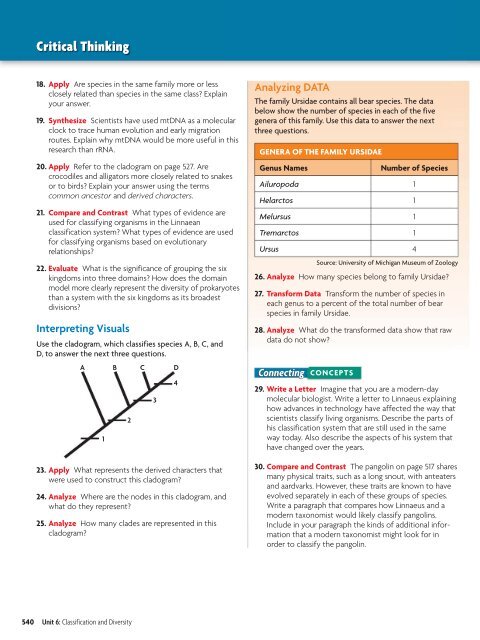Classification and Diversity
Classification and Diversity
Classification and Diversity
You also want an ePaper? Increase the reach of your titles
YUMPU automatically turns print PDFs into web optimized ePapers that Google loves.
Critical Thinking<br />
18. Apply Are species in the same family more or less<br />
closely related than species in the same class? Explain<br />
your answer.<br />
19. Synthesize Scientists have used mtDNA as a molecular<br />
clock to trace human evolution <strong>and</strong> early migration<br />
routes. Explain why mtDNA would be more useful in this<br />
research than rRNA.<br />
20. Apply Refer to the cladogram on page 527. Are<br />
crocodiles <strong>and</strong> alligators more closely related to snakes<br />
or to birds? Explain your answer using the terms<br />
common ancestor <strong>and</strong> derived characters.<br />
21. Compare <strong>and</strong> Contrast What types of evidence are<br />
used for classifying organisms in the Linnaean<br />
classification system? What types of evidence are used<br />
for classifying organisms based on evolutionary<br />
relationships?<br />
22. Evaluate What is the significance of grouping the six<br />
kingdoms into three domains? How does the domain<br />
model more clearly represent the diversity of prokaryotes<br />
than a system with the six kingdoms as its broadest<br />
divisions?<br />
Interpreting Visuals<br />
Use the cladogram, which classifies species A, B, C, <strong>and</strong><br />
D, to answer the next three questions.<br />
A B C D<br />
1<br />
23. Apply What represents the derived characters that<br />
were used to construct this cladogram?<br />
24. Analyze Where are the nodes in this cladogram, <strong>and</strong><br />
what do they represent?<br />
25. Analyze How many clades are represented in this<br />
cladogram?<br />
2<br />
3<br />
4<br />
Analyzing DATA<br />
The family Ursidae contains all bear species. The data<br />
below show the number of species in each of the five<br />
genera of this family. Use this data to answer the next<br />
three questions.<br />
GENERA OF THE FAMILY URSIDAE<br />
Genus Names<br />
Number of Species<br />
Ailuropoda 1<br />
Helarctos 1<br />
Melursus 1<br />
Tremarctos 1<br />
Ursus 4<br />
Source: University of Michigan Museum of Zoology<br />
26. Analyze How many species belong to family Ursidae?<br />
27. Transform Data Transform the number of species in<br />
each genus to a percent of the total number of bear<br />
species in family Ursidae.<br />
28. Analyze What do the transformed data show that raw<br />
data do not show?<br />
Connecting CONCEPTS<br />
29. Write a Letter Imagine that you are a modern-day<br />
molecular biologist. Write a letter to Linnaeus explaining<br />
how advances in technology have affected the way that<br />
scientists classify living organisms. Describe the parts of<br />
his classification system that are still used in the same<br />
way today. Also describe the aspects of his system that<br />
have changed over the years.<br />
30. Compare <strong>and</strong> Contrast The pangolin on page 517 shares<br />
many physical traits, such as a long snout, with anteaters<br />
<strong>and</strong> aardvarks. However, these traits are known to have<br />
evolved separately in each of these groups of species.<br />
Write a paragraph that compares how Linnaeus <strong>and</strong> a<br />
modern taxonomist would likely classify pangolins.<br />
Include in your paragraph the kinds of additional information<br />
that a modern taxonomist might look for in<br />
order to classify the pangolin.<br />
540 Unit 6: <strong>Classification</strong> <strong>and</strong> <strong>Diversity</strong>

















